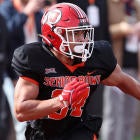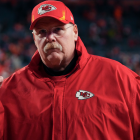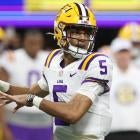The franchise tag, once again, will be sparely used in 2018. As the salary cap continues to grow in wider percentages and teams pump more of that money into extending their own top talent off of team-friendly rookie contracts, fewer blue-chip players are hitting the open market.
NFL free agency is fool's gold, and the word is out. So more teams are being proactive about securing their best talent before they play out their fifth-year options (in the case of first rounders) and therefore the tag isn't required nearly as often as in years past. The numbers have been down for several years and when the tagging period begins Feb. 20 – it's right around the corner! – I suspect we see perhaps less than a half-dozen clubs actually utilize it.
Most teams have no reason to even consider it, as the quality of their free agents – or lack thereof – makes it a no brainer not to apply a franchise tag. I do believe, however, that the transition tag could become a little more in vogue this offseason. The reality for this class is many of the players who teams will hotly debate tagging have either significant injury concerns (Ziggy Ansah and Sammy Watkins come to mind) and/or some big red flags off the field (Sheldon Richardson). That's where the rubber is hitting the road for these big-money decisions, as by and large clean best-of-breed players are reaching this point in their careers without having already secured a second contract.
So before I get into the handful of players I would place a tag on, let me address a few high-profile situations where I would let the market speak. Jarvis Landy is a very productive slot receiver who excels at yards after the catch. That he can make something out of nothing is a valuable weapon, for sure, but no way in hell am I placing a tag on him worth $16 million-plus. For a true outside, No. 1 receiver with ideal height and speed? Sure. But not here. Look at how many dynamic, uber-productive slot guys the Patriots have run their offense through for years (Wes Welker, Julian Edelman, Danny Amendola) without ever having to pay anything close to that kind of money. This is too steep for my blood.
And Watkins, to me, is an $8-$10 million receiver, maybe, but not close to this number. His foot has to remain a significant concern, as it has long hampered him. He is someone a Bills team sorely lacking skill guys eagerly traded away. Head coach Sean McVay's potent scheme can get guys open, and with a massive Aaron Donald extension a need, and the Rams trying to find a way to keep corner Trumaine Johnson after tagging him twice (yeah, that happened), well, this is a luxury they best not try to afford. Had Watkins had a monster year with McVay and Jared Goff last year, perhaps I'd consider more, but 39 catches for 593 yards and eight TDs isn't doing it for me. McVay can find an outside receiver in the draft.
Also, if I am the Carolina Panthers, I am trying like heck to tag guard Andrew Norwell, but I am not sure in the end they'll pull the trigger. They are already paying Trai Turner big money at guard, the offensive-line tag – $14 million-plus regardless of position (center/guard/tackle) – is super steep, and paying two top guards is next to impossible (see: Ravens signing Marshal Yanda then losing Kalechi Osemele to free agency). Ideally, I am tagging him to try to sign him long-term this summer – Cam Newton needs all the help he can get up front – but they have other needs, too.
As to which players I would tag:
Vikings: Case Keenum, QB (transition)
This is the quintessential use of a transition tag. Keenum is an anomaly, having a breakout season so late in his career. And he just lost his offensive coordinator/play caller, and the Vikings have no QB under contract who has thrown an NFL pass. No way I am getting to March 6 without still being tethered to an NFL passer, and no way am I considering Minnesota's other options (Sam Bradford and Teddy Bridgewater) for the spot. Save a few million bucks with the lower transition tag and rent Keenum for another year at $21 million (a touch more than what guys like Brock Osweiler and Mike Glennon earned last season) and see if the market speaks. Give Keenum, after such a career year, the chance to talk to other teams and see what else is out there; if someone offers something nuts, he walks. And if they don't, it may help facilitate a 2-3 year bridge contract by July 15 that offers some stability. It's too risky, to me, to wait til mid March and enter the Kirk Cousins sweepstakes – and with this defense and potential run game, a $30M quarterback might not be what Mike Zimmer needs, anyway.
Steelers: Le'Veon Bell, RB (franchise)
Total no brainer. Pittsburgh's long-term offer from last summer already included more money in the first two years of the deal than what it would cost the team to tag him in 2017 and 2018. Running backs tend to get hurt, mileage accrues quickly and Bell has faced suspensions for off-field behavior before, too. I'm not giving him $17 million a year on a long-term deal and no way in hell I am letting him hit the open market, either. Maybe his price tag comes down a little by July 15 this year and we can work out a longer deal. Maybe we get creative by then and try to work a three-year pact with him. But the tag has always been coming and it will be applied barring the sides working out an extension in the next few weeks.
Cowboys: Demarcus Lawrence, DE (franchise)
Young, potentially dominant pass rushers coming off impact years get tagged. Period. You have to do it. Dolphins should've kept Olivier Vernon, but that is the exception to the rule, with young, blossoming pass rushers like Melvin Ingram getting tagged recently, and even older ends like Jason Pierre-Paul, too. The Cowboys have holes on that defense already. Yes, Lawrence has had injury issues and suspension issues – which complicates a long-term deal – but for a team that believes it is in win-now mode (I'm not personally totally convinced), you have to pay this man his $17.5 million in 2018 to keep him off the open market. That's what a 14.5 sack-season in your walk year does for you. Jerry Jones has a way of wearing guys down over time and getting his deal at his price. Oh, and yeah, Dallas only has about $18 million in cap space, but I'll cut Dez Bryant to create ample room to carry Lawrence all season at $17.5 million against the cap if I have to.
Lions: Ziggy Ansah, DE (franchise)
The injury issues have been acute. And lingering. He hasn't been right in a couple of years. I get all of that … But he has flashed as an elite pass rusher and true difference maker in the past. And having just hired a rookie head coach in Matt Patricia who doesn't have too many blue-chip guys on his side of the ball, I'm not letting Ansah leave the building. I'll eat the $17.5 million against my cap if I have to. I don't take the chance on a transition tag. I am hoping there is a multi-year deal out there for us this summer, but at this stage for this franchise, I can't let a player with this sort of upside leave at a critical position when I have nearly $50 million in cap space.
Seahawks: Sheldon Richardson, DT (franchise)
Seattle gave up a decent haul to land him, to say the least. I want to do more than just rent him for one season – a season in which my team missed the playoffs, to boot. I'm shedding Kam Chancellor and Richard Sherman and Cliff Avril and some older players on defense, and I am keeping Richardson, at age 27, for at least one more year. He can be too much of an impact player – able to push the pocket inside or outside – to let him leave now. I would flirt with transitioning him at $11.7 million, but with his talent (and yeah, he has major warts off field and I have trepidation about a long-term deal) spend the other few million and get to $14.5 million to keep him. They'll have enough space once the purge begins and this kid in their scheme could be dominant. I have to keep someone over there.






















